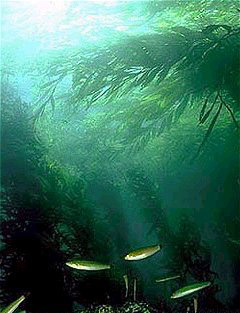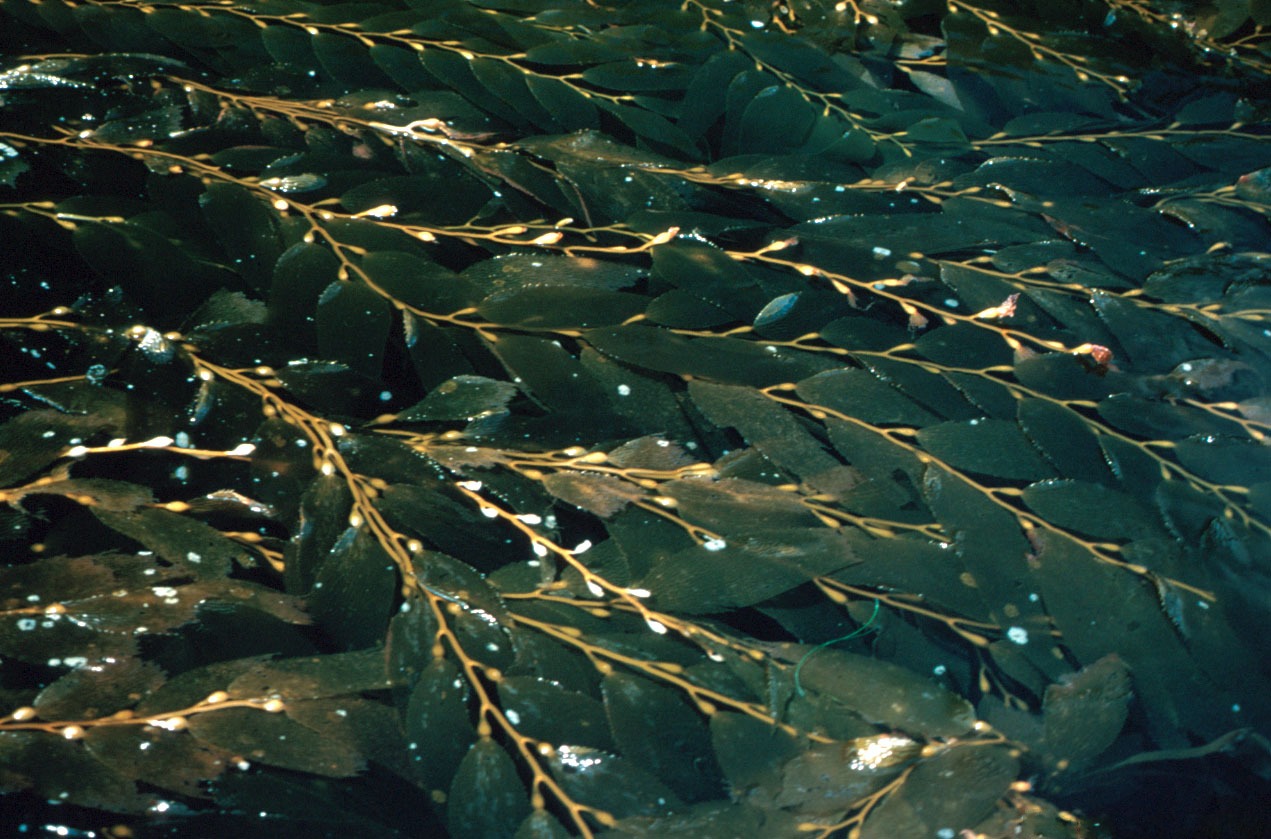|
Kelp
Kelps are large brown algae or seaweeds that make up the order (biology), order Laminariales. There are about 30 different genus, genera. Despite its appearance and use of photosynthesis in chloroplasts, kelp is technically not a plant but a stramenopile (a group containing many protists). Kelp grow from stalks close together in kelp forest, very dense areas like forests under shallow temperate and Arctic oceans. They were previously thought to have appeared in the Miocene, 5 to 23 million years ago based on fossils from California. New fossils of kelp holdfasts from early Oligocene rocks in Washington State show that kelps were present in the northeastern Pacific Ocean by at least 32 million years ago. The organisms require nutrient-rich water with temperatures between . They are known for their high growth rate—the genera ''Macrocystis'' and ''Nereocystis'' can grow as fast as half a metre a day (that is, about 20 inches a day), ultimately reaching .Thomas, D. 2002. ''Seaweed ... [...More Info...] [...Related Items...] OR: [Wikipedia] [Google] [Baidu] |
Kelp Forest
Kelp forests are underwater areas with a high density of kelp, which covers a large part of the world's coastlines. Smaller areas of anchored kelp are called kelp beds. They are recognized as one of the most productive and dynamic ecosystems on Earth. Although algal kelp forest combined with coral reefs only cover 0.1% of Earth's total surface, they account for 0.9% of global Primary production, primary productivity. Kelp forests occur worldwide throughout temperate and polar region, polar coastal oceans. In 2007, kelp forests were also discovered in tropical waters near Ecuador. Physically formed by brown macroalgae, kelp forests provide a unique habitat for marine organisms and are a source for understanding many ecological processes. Over the last century, they have been the focus of extensive research, particularly in Trophic dynamics, trophic ecology, and continue to provoke important ideas that are relevant beyond this unique ecosystem. For example, kelp forests can infl ... [...More Info...] [...Related Items...] OR: [Wikipedia] [Google] [Baidu] |
Macrocystis
''Macrocystis'' is a monospecific genus of kelp (large brown algae) with all species now synonymous with ''Macrocystis pyrifera''. It is commonly known as giant kelp or bladder kelp. This genus contains the largest of all the Phaeophyceae or brown algae. ''Macrocystis'' has pneumatocysts at the base of its blades. Sporophytes are perennial and the individual may live for up to three years; stipes/fronds within a whole individual undergo senescence, where each frond may persist for approximately 100 days. The genus is found widely in subtropical, temperate, and sub-Antarctic oceans of the Southern Hemisphere and in the northeast Pacific. ''Macrocystis'' is often a major component of temperate kelp forests. Despite its appearance, it is not a plant; it is a heterokont. Giant kelp is common along the coast of the northeastern Pacific Ocean, from Baja California north to southeast Alaska, and is also found in the southern oceans near South America, South Africa, Australia, and N ... [...More Info...] [...Related Items...] OR: [Wikipedia] [Google] [Baidu] |
Nereocystis
''Nereocystis'' (Greek, 'mermaid's bladder') is a monotypic genus of subtidal kelp containing the species ''Nereocystis luetkeana''. Some English names include edible kelp, bull kelp, bullwhip kelp, ribbon kelp, bladder wrack, and variations of these names. Due to the English name, bull kelp can be confused with southern bull kelps, which are found in the Southern Hemisphere. ''Nereocystis luetkeana'' forms thick beds on subtidal rocks, and is an important part of kelp forests. Etymology The species ''Nereocystis luetkeana'' was named (as ''Fucus luetkeanus'') after the German-Russian explorer Fyodor Petrovich Litke (also spelled Lütke) by Mertens. The species was renamed in a description by Postels and Ruprecht. Description ''Nereocystis'' is a brown macroalgae that derives chemical energy from photosynthesis. ''Nereocystis'' in particular, similar to ''Pelagophycus porra'', can be identified by a single large pneumatocyst between the end of its hollow stipe and the b ... [...More Info...] [...Related Items...] OR: [Wikipedia] [Google] [Baidu] |
Brown Algae
Brown algae (: alga) are a large group of multicellular algae comprising the class (biology), class Phaeophyceae. They include many seaweeds located in colder waters of the Northern Hemisphere. Brown algae are the major seaweeds of the temperate and polar regions. Many brown algae, such as members of the order Fucales, commonly grow along rocky seashores. Most brown algae live in marine environments, where they play an important role both as food and as a potential habitat. For instance, ''Macrocystis'', a kelp of the order Laminariales, may reach in length and forms prominent underwater kelp forests that contain a high level of biodiversity. Another example is ''Sargassum'', which creates unique floating mats of seaweed in the tropical waters of the Sargasso Sea that serve as the habitats for many species. Some members of the class, such as kelps, are used by humans as food. Between 1,500 and 2,000 species of brown algae are known worldwide. Some species, such as ''Ascophyllum ... [...More Info...] [...Related Items...] OR: [Wikipedia] [Google] [Baidu] |
Stramenopile
The stramenopiles, also called heterokonts, are protists distinguished by the presence of stiff tripartite external hairs. In most species, the hairs are attached to flagella, in some they are attached to other areas of the cellular surface, and in some they have been secondarily lost (in which case relatedness to stramenopile ancestors is evident from other shared cytological features or from genetic similarity). Stramenopiles represent one of the three major clades in the SAR supergroup, along with Alveolata and Rhizaria. Stramenopiles are eukaryotes; most are single-celled, but some are multicellular including some large seaweeds, the brown algae. The group includes a variety of algal protists, heterotrophic flagellates, opalines and closely related proteromonad flagellates (all endobionts in other organisms); the actinophryid Heliozoa, and oomycetes. The tripartite hairs characteristic of the group have been lost in some of the included taxa – for example in most ... [...More Info...] [...Related Items...] OR: [Wikipedia] [Google] [Baidu] |
Seaweed
Seaweed, or macroalgae, refers to thousands of species of macroscopic, multicellular, marine algae. The term includes some types of ''Rhodophyta'' (red), '' Phaeophyta'' (brown) and ''Chlorophyta'' (green) macroalgae. Seaweed species such as kelps provide essential nursery habitat for fisheries and other marine species and thus protect food sources; other species, such as planktonic algae, play a vital role in capturing carbon and producing at least 50% of Earth's oxygen. Natural seaweed ecosystems are sometimes under threat from human activity. For example, mechanical dredging of kelp destroys the resource and dependent fisheries. Other forces also threaten some seaweed ecosystems; for example, a wasting disease in predators of purple urchins has led to an urchin population surge which has destroyed large kelp forest regions off the coast of California. Humans have a long history of cultivating seaweeds for their uses. In recent years, seaweed farming has become a global ... [...More Info...] [...Related Items...] OR: [Wikipedia] [Google] [Baidu] |
Lamina (algae)
The lamina or blade in macroscopic algae, like seaweed, is a generally flattened structure that typically forms the principal bulk of the thallus. It is often developed into specialised organs such as pneumatocyst, flotation bladders and reproductive organs. The lamina is typically an expansion of the stipe (botany), stipe which in term is attached to the substrate by the holdfast (biology), holdfast. References Brown algae {{Phaeophyceae-stub ... [...More Info...] [...Related Items...] OR: [Wikipedia] [Google] [Baidu] |
Oligocene
The Oligocene ( ) is a geologic epoch (geology), epoch of the Paleogene Geologic time scale, Period that extends from about 33.9 million to 23 million years before the present ( to ). As with other older geologic periods, the rock beds that define the epoch are well identified but the exact dates of the start and end of the epoch are slightly uncertain. The name Oligocene was coined in 1854 by the German paleontologist Heinrich Ernst Beyrich from his studies of marine beds in Belgium and Germany. The name comes from Ancient Greek (''olígos'') 'few' and (''kainós'') 'new', and refers to the sparsity of Neontology, extant forms of Mollusca, molluscs. The Oligocene is preceded by the Eocene Epoch and is followed by the Miocene Epoch. The Oligocene is the third and final epoch of the Paleogene Period. The Oligocene is often considered an important time of transition, a link between the archaic world of the tropical Eocene and the more modern ecosystems of the Miocene. Major chang ... [...More Info...] [...Related Items...] OR: [Wikipedia] [Google] [Baidu] |
Mucilage
Mucilage is a thick gluey substance produced by nearly all plants and some microorganisms. These microorganisms include protists which use it for their locomotion, with the direction of their movement always opposite to that of the secretion of mucilage. It is a polar glycoprotein and an exopolysaccharide. Mucilage in plants plays a role in the storage of water and food, seed germination, and thickening membranes. Cacti (and other succulents) and flax seeds are especially rich sources of mucilage. Occurrence Exopolysaccharides are the most stabilising factor for microaggregates and are widely distributed in soils. Therefore, exopolysaccharide-producing "soil algae" play a vital role in the ecology of the world's soils. The substance covers the outside of, for example, unicellular or filamentous green algae and cyanobacteria. Amongst the green algae especially, the group Volvocales are known to produce exopolysaccharides at a certain point in their life cycle. It occu ... [...More Info...] [...Related Items...] OR: [Wikipedia] [Google] [Baidu] |
Pseudochordaceae
''Pseudochorda'' is a genus of thalloid brown algae Brown algae (: alga) are a large group of multicellular algae comprising the class (biology), class Phaeophyceae. They include many seaweeds located in colder waters of the Northern Hemisphere. Brown algae are the major seaweeds of the temperate ... including two species. References Further reading * Laminariales Laminariales genera {{Phaeophyceae-stub ... [...More Info...] [...Related Items...] OR: [Wikipedia] [Google] [Baidu] |
Aureophycaceae
''Aureophycus'' is a genus of kelp Kelps are large brown algae or seaweeds that make up the order (biology), order Laminariales. There are about 30 different genus, genera. Despite its appearance and use of photosynthesis in chloroplasts, kelp is technically not a plant but a str ... native to the waters of Karamil Island in the Aleutians, comprising a single species ''Aureophycus aleuticus'', formally described in 2008. Each frond is long by wide with a strong yellow vein running along each edge (central vein lacking). A 2013 study found the genus to be basal to Laminariales. References Laminariales Monotypic brown algae genera {{Phaeophyceae-stub ... [...More Info...] [...Related Items...] OR: [Wikipedia] [Google] [Baidu] |
Pneumatocyst
In phycology, a pneumatocyst is a floating structure that contains gas found on brown seaweed. A seaweed's thallus may have more than one. They provide buoyancy to lift the blades toward the surface, allowing them to receive more sunlight for photosynthesis Photosynthesis ( ) is a system of biological processes by which photosynthetic organisms, such as most plants, algae, and cyanobacteria, convert light energy, typically from sunlight, into the chemical energy necessary to fuel their metabo .... The proportion of gases in the pneumatocysts varies depending on the physiological status of the alga and the partial pressure of gases in the surrounding air or water. The pneumatocyst can hold O2, CO2, N2, and CO. References Further reading Brown algae {{Phaeophyceae-stub ... [...More Info...] [...Related Items...] OR: [Wikipedia] [Google] [Baidu] |








